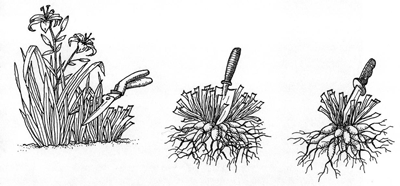The Right Place
Careful attention to cultural requirements assures that plants are happy and stress free. Stress free plants are less likely to experience problems. Daylilies prefer full sun, at least six hours daily, in the North but do better in light afternoon shade in the South. The flowers follow the sun, pointing southeast in the morning and moving to southwest in the afternoon. Plant them so they will face viewers, such as along the north side of a path. Because their tuberous roots store water and nutrients, daylilies can compete easily with tree roots. Plant them in moist, well-drained soil. Don't make it too rich, because excessive fertility leads to excessive foliage growth and poor flowering. Though they'll tolerate almost any type of soil, it should be slightly acid to neutral (pH 5.5 to 7.0).
Planting Nursery Stock
Plant daylilies in the spring, late summer or very early fall. Try to have them planted by 5 or 6 weeks before the first frost is expected in your area. They tolerate transplanting almost any time the soil is not frozen, except in the South where summer heat sabotages young transplants. Plants will come bare-rooted in the mail or in small pots from garden centers. Keep roots moist until planting time.
Prepare the planting area by clearing it of sticks and debris. With a shovel or trowel dig up and turn over the soil to loosen it down 8 or 10 inches. Remove any rocks and rake the soil surface smooth and level. Remove the young plants from their wrappings or container.
Dig a hole that is about as deep as the container and slightly wider. Set the plant in the hole, making sure the crown, where the roots meet the stems, sits only an inch or so below the soil surface. Fill in around the plant with soil, gently firming it to eliminate air pockets down by the roots. Water well and mulch. Plant individual young daylily plants 2 feet apart. For a more dramatic show, place groups of 3 plants within a 4 foot area. It takes a year for plants to take firm root.
Amendments In Planting or Transplanting
There are a number of products at the garden center that will help your newly planted or transplanted plants deal better with the stress inherent in the planting process. All healthy plants have beneficial fungi, called mycorrhizal fungi, living on their roots. You can buy these valuable additions to your plant’s ecosystem. See the file describing Using Micorrhizae When Planting.
In addition, there are a number of products such as seaweed, compost tea, and beneficial soil microbes that when added to the planting process will help your newly established plants get going faster. See the file New Technology In Plant Growth Activators
 |
Propagating Daylilies
The easiest way to acquire more daylily plants is to divide the ones you have. You can do this any time over the season, but the best time to do this is in the fall. If they already have foliage, cut it back by half. Then dig up the oversized plant clump so its roots are lifted completely out of the soil. With a sharp spade or large knife cut the clump into several individual chunks that have roots attached.
Discard any old woody sections. Then replant the smaller rooted plant chunks at the same depth as the original plant. If the original clumps are at least a foot across, the chances for bloom the same season from the new divisions are better. Some daylilies seem to be able to go on forever, but many are revitalized if divided every 4 to 6 years in spring or later, in September.

